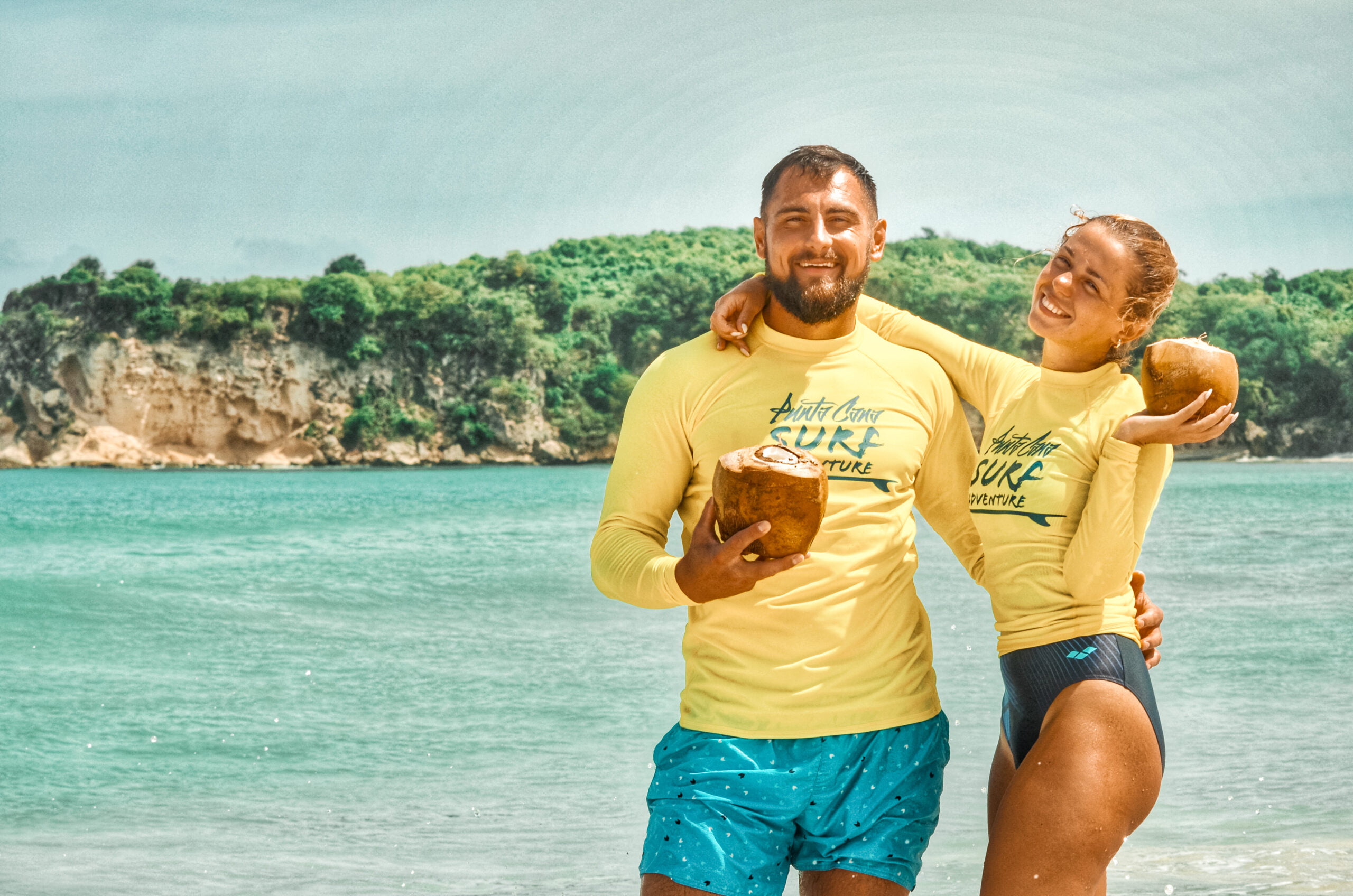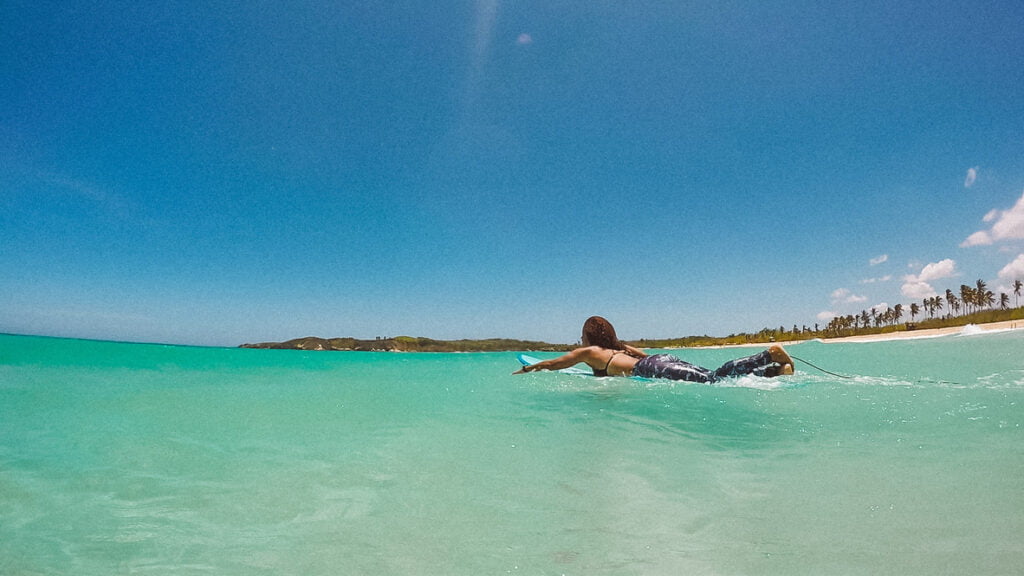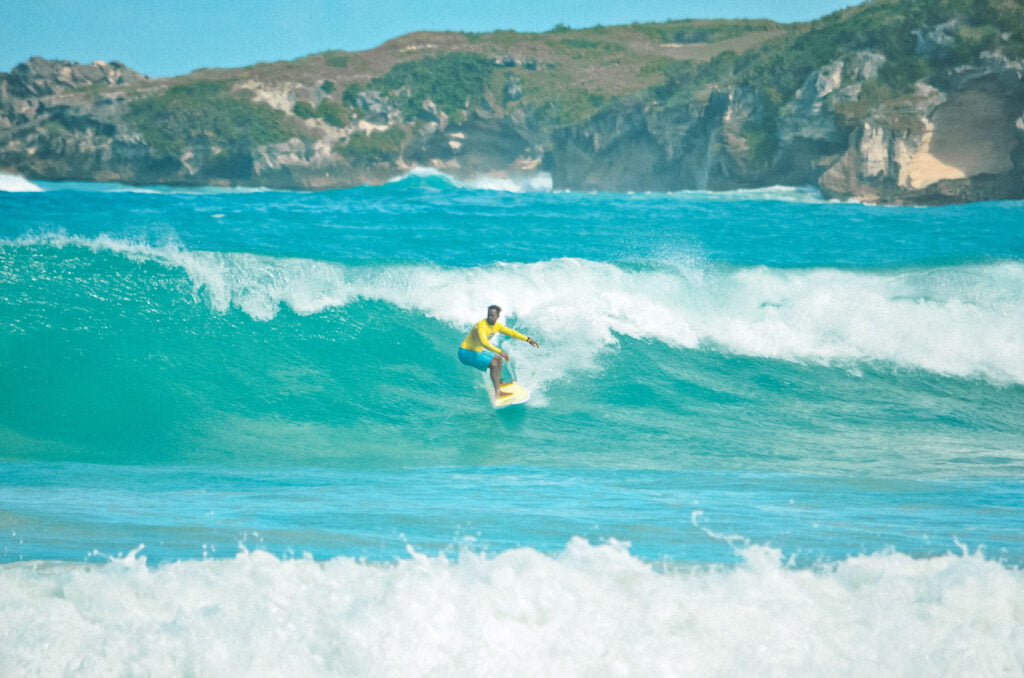WHAT TO WEAR FOR SURFING IN WARM WATERS 👙🩳: A Beginner’s Guide
After debating with yourself for days (if not weeks or months), you have finally signed up for that first surf lesson for your upcoming Caribbean vacation. Good job!
As you pack your suitcase, there lay your 4 sets of tiny bikinis, next to your boyfriend’s speedos, and you imagine yourself in your expensive 3 square inches of fabric, gliding on a surfboard with the rolling waves behind you, and you can already feel the Instagram success waiting to happen, if you just make sure some photographer on the beach makes that shot!
But not so fast! (Sound of tires screeching to a halt)
Sorry to burst your bubble but let me just give you a better picture of what is really going to happen on that first surf lesson and what -from personal experience- I recommend you to wear to ensure you have fun, are comfortable, and don’t get injured (I’m not kidding! Sunburn is serious!).
This is not an unusual dilemma if you have never surfed before, and if you come from a place where the water is normally VERY cold, then these are valid questions that I am happy to answer.
Let’s start by what universally works in warm waters. I’ll use as reference the warm waters of my Caribbean paradise in Punta Cana, where the temperature is a yearly average of 80°F (26.67°C).
ESSENTIALS
-
RASHGUARD
 In the tropics, the sun is no joke: it burns you, fast and strong, in cloudy and clear days alike! Rashguards may be the best invention for surfers since the surfboard!
In the tropics, the sun is no joke: it burns you, fast and strong, in cloudy and clear days alike! Rashguards may be the best invention for surfers since the surfboard!
Rashguards not only prevent belly-rash, caused by rubbing your belly against the board, but also provide excellent sun protection for your upper body.
A quality rashguard should be made of good material and be at least 50+ SPF (most surf brands carry rashguards that meet this criteria).
Most surf schools offer rashguards, but make sure that your school of choice offers them. If they are long sleeved, even better. That is if you do not want a trucker’s tan, but to each their own!
-
WETSUIT
THANK GOD NO!!!! Here in Punta Cana you will not need a wetsuit. While in the water, during winter months, you might find some instructors wearing 1mm or springsuits, only because we are wet or in the water for most of the day, and a wetsuit will offer protection against getting too cold. But for a 2-hour lesson you will not need a wetsuit at all.

-
HAT
If the skin on your face is sensitive, or you simply want to add additional protection to your face, wearing a hat is possible. If you do not have a full head of hair, you must seriously consider a hat, to avoid getting your scalp sunburned.
Find a hat or cap that is specifically designed for surfing, with a short brim (as you need to have enough visibility to the sides) and should have a tie around your chin that can be tighten comfortably. The best surfing hats normally have neoprene ties that are safe, comfortable, durable and are secured with plastic buckles.
ADDITIONAL TIPS FOR THE LADIES
-
ONE-PIECE SWIMSUIT
If you don’t feel like wearing a rashguard since you only have two more days left of your vacation to work on your tan, by all means go ahead, but a one piece suit might stay better in place.
-
BIKINIS
If you are a bikini kind of gal, I highly recommend that you wear a really tight bottom, at least one size smaller than what you normally wear, or you will be showing off more than your surfing skills in the water!
Whichever type of swimsuit you use, I recommend that it does not tie at the neck. Having a string pulling down your neck while you are being active, can be a real literal pain, specially if you are gifted with a large bust.
No knots or accessories on the front of your bikini or swimsuit! Those just get in the way and will poke you when lying down on the board.
-
LEGGINGS

I personally wear leggings to surf all the time, and for me they are as much an essential as rashguards. I suggest them for protecting your legs from the sun, and if you have sensitive skin, they prevent you from getting a rash on the front of your thighs when lying down on the board, or in your inner thighs when sitting on our board with your legs on both sides.
Any lycra workout leggings will do the job. Avoid cotton material as it absorbs and retains water.
Keep in mind that if you surf shortly after shaving your thighs, you will be more prone to skin irritation. And if you have hair in your thighs it will get caught and pulled by the wax on the board.
-
BOARDSHORTS
If you are modest or simply don’t have a tight bikini-bottom, you can always wear boardshorts (conveniently named, because they are perfect for surfing!) . These are shorts that stay put, dry quickly and are super comfy!!
ADDITIONAL TIPS FOR THE GENTLEMEN
For men the surfing attire in warm water could not be simpler! Here are a couple of things I dare to recommend!
-
BOARDSHORTS

They are a much better option than swim trunks or speedos, just because the length will prevent rash on your thighs, and the wax from pulling out the hair of your legs, OUCH! They are also stretchy and dry quickly. Today’s technology in boardshorts is simply mind blowing!
-
LEGGINGS OR COMPRESSION BRIEFS
Worn under the boardshorts. For additional sun protection, rash prevention and avoiding the very common salt water rash around delicate areas!! You’re welcome 🙂
Keep in mind that these are only suggestions, that from experience, will at least help you be comfortable and concentrate on your surfing, not on your bathing suit being all over the place, or with your belly burning from a rash.
Wear whatever you think will work for you, knowing that no matter what you have on, you will look like an absolute rockstar once you stand on a surfboard and smile for the camera! 📸






